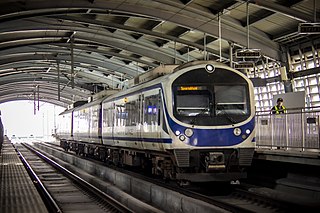
The Airport Rail Link (ARL) is an express and commuter rail line in Bangkok, Thailand. The line provides an airport rail link from Suvarnabhumi Airport, via Makkasan station, to Phaya Thai station in central Bangkok. Most of the line is on a viaduct over the main eastern railway. It is owned by State Railway of Thailand (SRT) and, since 2021, operated by Asia Era One Company Limited. The 28.6-kilometer (17.8 mi)-long Airport Rail Link opened for service on 23 August 2010.

The Elevated Train in Commemoration of HM the King's 6th Cycle Birthday 2nd line, also known as Silom Line, is one of the rapid transit lines of the BTS Skytrain System in Bangkok, Thailand.The line runs eastward from National Stadium Station in Pathum Wan District over Rama I Road and interchanges with the Sukhumvit Line at Siam station, then turns southward, following Ratchadamri, Si Lom, Naradhiwas Rajanagarindra and Sathon Roads to Taksin Bridge where it crosses the Chao Phraya River to the Thonburi side of Bangkok and Wong Wian Yai. It continues west along the Ratchapruek Road before it terminates at Bang Wa Station in Phasi Charoen District.

Rail transport plays a crucial role in connecting various regions of Thailand, transporting both goods and passengers through a range of transportation options that include inter-city and commuter rail, mass rapid transit, monorails, and airport rail links. The State Railway of Thailand (SRT) operates a network of intercity railways spanning 4,845.1 kilometers, covering 47 provinces across the country. SRT is committed to developing railway lands through its subsidiary, SRT Asset (SRTA), which focuses on transit-oriented development (TOD) initiatives. The Krung Thep Aphiwat Central Terminal in Bangkok serves as the primary transportation hub for rail transport in Thailand, connecting various types of rail transportation throughout the country. It covers an area of 274,192 square meters, making it the largest railway station in Southeast Asia, and is situated in a new central business district (CBD) that is currently being developed.

The SRT Dark Red Line, is part of the SRT Red Line suburban railway system to serve the greater Bangkok Metropolitan Region running for 26 km (16 mi) between Krung Thep Aphiwat and Rangsit.

The SRT Light Red Line, or Nakhon Withi Line is a 15 km (9.3 mi) between Krung Thep Aphiwat Central Terminal and Taling Chan and is part of the SRT Red Lines suburban railway system serving the greater Bangkok Metropolitan Region.

Hua Lamphong station is a rapid transit station on the Blue Line of the Bangkok MRT in Thailand. It is located underground on Rama IV Road in front of Bangkok railway station, more commonly known locally as "Hua Lamphong", on the former location of Hua Lamphong railway station, the origin of Paknam Railway, the first railway line in Thailand.
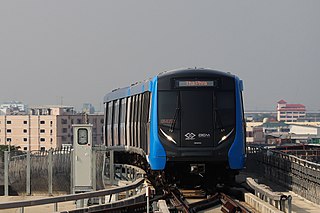
The MRT Blue Line or MRT Chaloem Ratchamongkon Line is Bangkok's third rapid transit line, following the Sukhumvit line and Silom line of the BTS Skytrain. It is the first line of the MRT system and is operated by Bangkok Expressway and Metro (BEM). The original 20 km (12.43 mi) MRT Blue Line from Hua Lamphong to Bang Sue opened on 3 July 2004. A 1.2 km (0.75 mi) extension to Tao Poon opened on 11 August 2017. The 15.9 km (9.88 mi) western extension to Lak Song opened for full service on 29 September 2019 and the 11 km (6.84 mi) extension from Tao Poon to Tha Phra to form the quasi loop, opened for full service on 30 March 2020.

Bang Sue Junction, is a railway station and junction located in Bangkok. It is situated on Thoet Damri Road, Bang Sue district. It is owned and operated by State Railway of Thailand, serves the Northern, Northeastern, and Southern Lines, and is a junction for the North/Northeast and South Lines.

Bang Bamru station is a railway station located at Bang Phlat Subdistrict, Bang Phlat District, Bangkok. It is a class 1 station and serves two systems operated by the State Railway of Thailand, Southern Line and the SRT Light Red Line. It is located 17.94 kilometres (11.1 mi) from Bangkok railway station.

The Northern Line is a railway line in Thailand, running between the capital Bangkok and the northern city of Chiang Mai. It is the second longest railway line in Thailand at 751 kilometres (467 mi) long, has 130 operational stations and halts, and is operated by the State Railway of Thailand. The line first opened in 1896. Major cities served by the line include Bangkok, Ayutthaya, Nakhon Sawan, Phitsanulok, Lampang, and Chiang Mai.

Bang Sue MRT station is a Bangkok MRT rapid transit station on the MRT Blue Line, located near Bang Sue Junction railway station, in Bangkok. It connects to SRT Dark Red Line and SRT Light Red Line at Krung Thep Aphiwat Central Terminal located above the station. Its symbol color is blue.
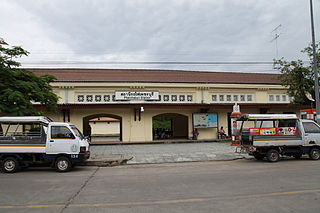
Phetchaburi railway station is a railway station located in Khlong Krachaeng Subdistrict, Phetchaburi City. It is a class 1 railway station.

Chumphon railway station is a railway station in Tha Taphao Subdistrict, Chumphon City, and is the main railway station for Chumphon Province. It is a class 1 railway station, 468.534 km (291.1 mi) from Thon Buri railway station. It is the first fueling station from Bangkok, and thus all trains going further south must stop here. Chumphon is also the site of a locomotive depot.

Thon Buri railway station formerly known as Bangkok Noi railway station (สถานีรถไฟบางกอกน้อย), is a class 1 railway station and the current terminus of the Thon Buri Branch Line in Bangkok. Near the station is a railway depot that keeps five functional steam locomotives operable for four special occasions. Thon Buri station is the only station in Bangkok that has railway semaphore signals still present on the station grounds.

Krung Thep Aphiwat Central Terminal, also known by its former name Bang Sue Grand Station, is the central passenger terminal in Bangkok and the current railway hub of Thailand. It replaced the existing Hua Lamphong railway station as the city's central railway station, with long-distance rail services operating from here from 19 January 2023. The station was opened on 2 August 2021 as part of the operation of the SRT Red Lines, and from May 2021 to September 2022 served as a COVID-19 vaccination center. It is linked to the Bang Sue MRT station via an underground walkway.

Don Mueang station is a railway station in Bangkok. It is located opposite Don Mueang International Airport. It currently serves the SRT Dark Red Line and long-distance intercity trains on the Northern and Northeastern Line of the State Railway of Thailand. There is a pedestrian bridge directly linking the new station to the airport.
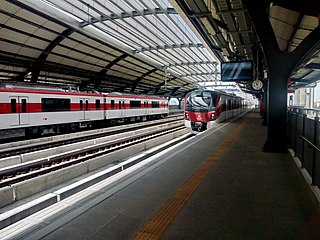
Lak Si Station is a railway station in the area of Bangkok's Lak Si district. It serves the SRT Dark Red Line and MRT Pink Line.

Thung Song Hong Station is a railway station in Lak Si District, Bangkok. It serves the SRT Dark Red Line.
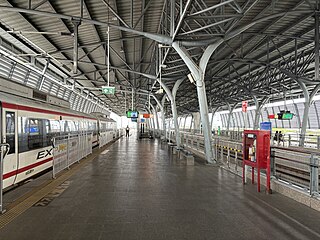
Hua Mak station is a station on the Eastern Line of the State Railway of Thailand, an Airport Rail Link station and an MRT station on the Yellow Line, located on Srinagarindra Road in Phatthanakan Subdistrict, Suan Luang District, Bangkok. Three rail operators run the station complex separately at their respective stations, with no interchanges between the three stations.



![A sign protesting the station closure reads ""Stop destroying [Thai] rail history. Cancel the closure of Hua Lamphong [station]. #SAVE Hua Lamphong" at Nakhon Lampang station Nakhon Lampang Railway Station sthaaniirthaif nkhrlampaang (Dec 2021) IMG 06.jpg](http://upload.wikimedia.org/wikipedia/commons/thumb/f/fd/Nakhon_Lampang_Railway_Station_%E0%B8%AA%E0%B8%96%E0%B8%B2%E0%B8%99%E0%B8%B5%E0%B8%A3%E0%B8%96%E0%B9%84%E0%B8%9F_%E0%B8%99%E0%B8%84%E0%B8%A3%E0%B8%A5%E0%B8%B3%E0%B8%9B%E0%B8%B2%E0%B8%87_%28Dec_2021%29_IMG_06.jpg/220px-Nakhon_Lampang_Railway_Station_%E0%B8%AA%E0%B8%96%E0%B8%B2%E0%B8%99%E0%B8%B5%E0%B8%A3%E0%B8%96%E0%B9%84%E0%B8%9F_%E0%B8%99%E0%B8%84%E0%B8%A3%E0%B8%A5%E0%B8%B3%E0%B8%9B%E0%B8%B2%E0%B8%87_%28Dec_2021%29_IMG_06.jpg)


































